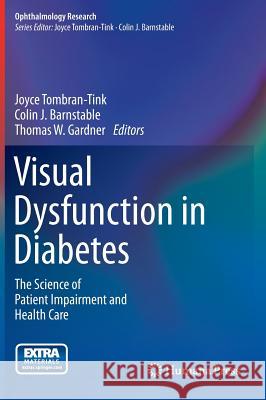Visual Dysfunction in Diabetes: The Science of Patient Impairment and Health Care » książka
Visual Dysfunction in Diabetes: The Science of Patient Impairment and Health Care
ISBN-13: 9781607611493 / Angielski / Twarda / 2011 / 379 str.
An exciting contribution to the field, Visual Dysfunction in Diabetes: The Science of Patient Impairment and Improvement is designed with two overriding objectives: to help readers understand the impact of vision impairment in people living daily with diabetes rather than considering diabetic retinopathy solely as a medical problem, and to explore what we know and don't know about the ways diabetes affect the eye. With the plethora of new information being generated, there are still a series of fundamental questions that must be addressed if effective treatments for diabetic retinopathy are to be found and applied. Developed by a renowned group of authorities, Visual Dysfunction in Diabetes: The Science of Patient Impairment and Improvement offers responses and context for a range of questions, such as: do metabolic factors beyond glucose contribute to vision-threatening diabetic retinopathy? If so, how do these lead to vision impairment? Is diabetic retinopathy a response to systemic metabolic abnormalities or are there unique ocular problems related to insulin resistance? What is the relationship between the neural, vascular, and inflammatory abnormalities in diabetic retinopathy? Do they represent a pathological cascade induced sequentially or simultaneous responses to one or more metabolic perturbations? The authors note that if we do not address these types of questions, it is possible that the long process of developing new therapeutics will target only one arm of the pathology and leave the retina open to damaging consequences of the others. State-of-the-art, comprehensive, and an invaluable addition the research and clinical literature, Visual Dysfunction in Diabetes: The Science of Patient Impairment and Improvement offers guidance and a significant step toward new scientific approaches that can lessen the devastating vision impairment associated with diabetes.
An exciting contribution to the field, Visual Dysfunction in Diabetes: The Science of Patient Impairment and Improvement is designed with two overriding objectives: to help readers understand the impact of vision impairment in people living daily with diabetes rather than considering diabetic retinopathy solely as a medical problem, and to explore what we know and don't know about the ways diabetes affect the eye. With the plethora of new information being generated, there are still a series of fundamental questions that must be addressed if effective treatments for diabetic retinopathy are to be found and applied. Developed by a renowned group of authorities, Visual Dysfunction in Diabetes: The Science of Patient Impairment and Improvement offers responses and context for a range of questions, such as: do metabolic factors beyond glucose contribute to vision-threatening diabetic retinopathy? If so, how do these lead to vision impairment? Is diabetic retinopathy a response to systemic metabolic abnormalities or are there unique ocular problems related to insulin resistance? What is the relationship between the neural, vascular, and inflammatory abnormalities in diabetic retinopathy? Do they represent a pathological cascade induced sequentially or simultaneous responses to one or more metabolic perturbations? The authors note that if we do not address these types of questions, it is possible that the long process of developing new therapeutics will target only one arm of the pathology and leave the retina open to damaging consequences of the others. State-of-the-art, comprehensive, and an invaluable addition the research and clinical literature, Visual Dysfunction in Diabetes: The Science of Patient Impairment and Improvement offers guidance and a significant step toward new scientific approaches that can lessen the devastating vision impairment associated with diabetes.











